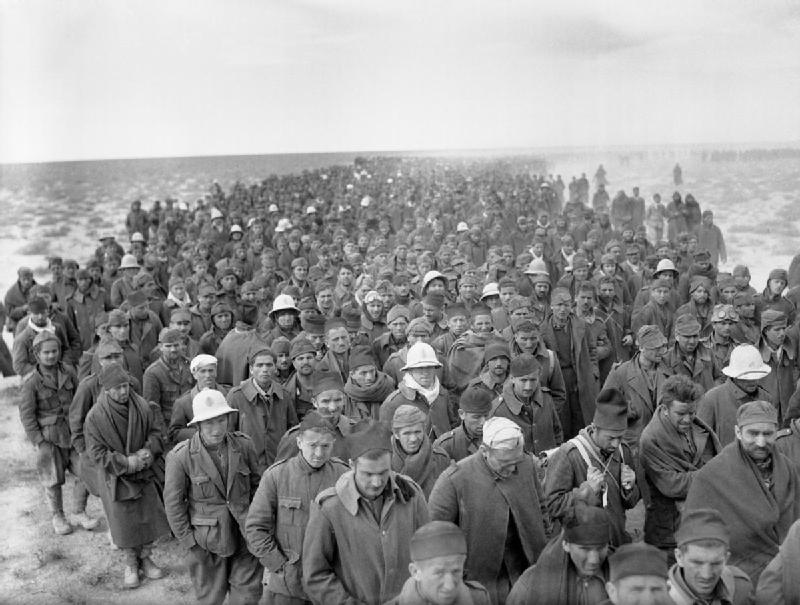64a Divisione autotrasportabile “Catanzaro” tipo A.S.
The service history of the 64th Catanzaro Division was ill-starred throughout its brief existence. The 64th Catanzaro Division was formed in late May/early June 1940 in Cyrenaica. To form this new division, the 203rd Artillery Regiment and certain other the support and service troops of the disbanded 3rd CC.NN. Division “21 Aprile” were utilized. The majority of the troops however were newly raised and the division’s two infantry regiments (141st, 142nd) were completely green. It should have taken six months to work this division up to level acceptable for a combat formation, but it was not to get it.
On formation, the division was composed of the following elements:
- 141st Infantry Regiment
- 142nd Infantry Regiment
- 203rd Artillery Regiment
- 64th Machinegun Battalion
- 64th Mixed Engineer Battalion
- 64th Antitank Company
After only two months of training, the Catanzaro Division was activated for war service even though it was rated as being not capable of combat operations. In the “great invasion” of Egypt in September 1940, the Catanzaro was placed in reserve at Tobruk. Only after Italian forces had consolidated their positions in the Sidi al-Barrani area was the inestimable Catanzaro Division brought forward. On October 5th 1940, the Catanzaro Division, supposedly a semi-motorized formation, had 105 trucks on strength of which only 39 were working. The 63rd Cirene Division on the same day had 274 trucks on strength of which 192 were working. The situation in terms of weapons and other equipment was similar if not so bad. In true awareness of the unique qualities of this division, the Italian command chose not to deploy any units to reinforce the Catanzaro Division in its positions southeast of Buq Buq in the region of Alam Samalus. It was in these positions, the Catanzaro Division found itself at the start of Operation Compass. Fortunately for the men of the Catanzaro Division, the initial British attack did not fall upon them as had been the case in the original draft of the British operational plan.
After the destruction of the Italian forces in the military camps in and around Sidi al-Barrani, the remaining Italian forces in Egypt were ordered to withdraw back into Libya. While the Cirene Division (deployed to the south of the Catanzaro Division in the Sofafi area) was able to side slip the advancing Commonwealth forces using its greater mobility, the slow moving 64th Catanzaro Division was confronted by the 7th Armoured Brigade (plus some troops from the support group) as it began its retreat. The British 7th Armoured Brigade caught the Catanzaro a few miles west of Buq Buq. The divisional artillery engaged the tanks, either in a desultory manner or to some effect depending upon the sources you read. When the tanks closed, the mass of the division quickly surrendered showing its ill trained men (and bad officers) had no desire to fight. The lead elements of the retreating columns of the division managed to escape the collapse, and passed into the fortress of Bardia. These remnants showed they were of like mind of their former comrades, and played no role, that I know of, during the battle for Bardia. When the last troops in the fortress surrendered on January 6th 1941, the sorry history of the 64th Catanzaro Truckborne Infantry Division finally ended. There were no plans ever conceived to reform this miserable division.
As you can see below, I accept the current rating of the 64th Division in WitD. However, the rating given for the other 60 series division is not, I think, as accurate as it could be. The 60th to 63rd Divisions had been existence for some time, and were the best equipped of any of the Italian divisions at least in terms of transport. They had an Achilles heel, which was the fact they were still organized under the 1938 organizational scheme, and thus were woefully short of close support weapons even as compared to a standard Italian infantry division of 1940. Thus I give this class of divisions a 3-8 rating. The Catanzaro Division lacking training, transport, and anything resembling leadership amongst its officers is doing well to receive a 2-6 rating. The higher rating of the 60 series divisions is available to the Catanzaro on the assumption that further training would have allowed the Italian command to remove from the division of its cadre of misfits and incompetents and set up a proper training programme for the division
As for the Dec I 1940 Scenario, the 64th Catanzaro Division was deployed not in Buq Buq itself (eg. 19A:0519) but to the southeast of it in (19A:0619).
MAY II 1940
Place in Forming (Cyrenaica Military Region):
2x 1-8 Infantry III 141, 142
1x 8 Infantry XX HQ 64 Cat
AUG I 1940
Optional: Remove from Forming (Cyrenaica Military Region)
2x 1-8 Infantry III 141, 142
1x 8 Infantry XX HQ 64 Cat
and place instead in any City in Cyrenaica Military Region:
1x 2-6 Infantry XX 64 Cat
DEC I 1940
If not received in Aug I 1940 as optional reinforcement, then
Full; Place in any city in Cyrenaica Military Region:
2x 1-8 Infantry III
1x 8 Infantry XX HQ 64 Cat
Add to Breakdown Display:
1x 3-8 Infantry XX 64 Cat
Dec I 1940 Scenario Deployment
19A:0619:
1x 2-6 Infantry XX 64 Cat
(no other units in the stack)
